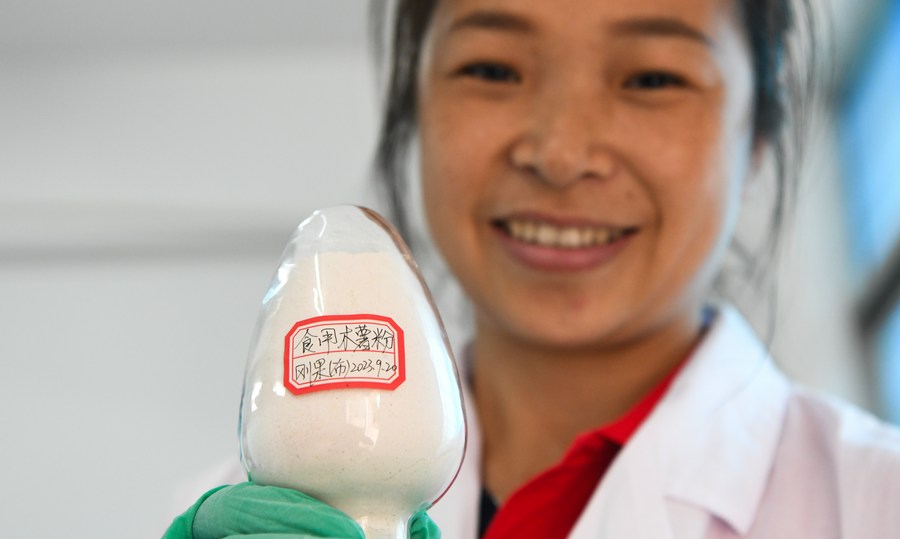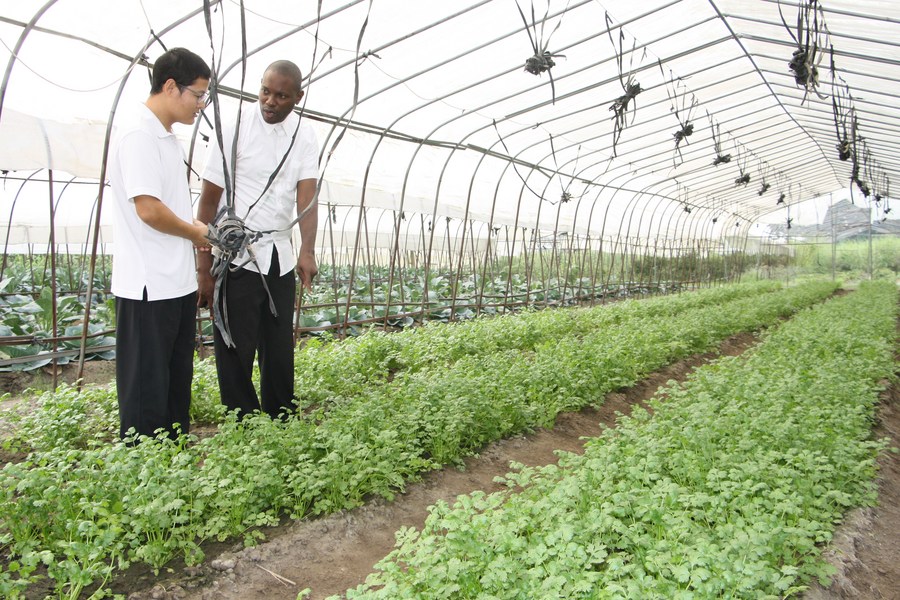* Chinese agronomists plan to expand the area dedicated to new cassava varieties and advanced farming techniques to over 500,000 hectares in Africa.
* The cooperation has also expanded to the industrial sector, bringing automatic production lines of cassava flour, biscuits and crisps to more African countries.
* The increased output of the starchy crop is expected to bolster food security in Africa while reducing poverty by raising small farmers' income.
SANYA, Nov. 19-- Inside an agriculture demonstration center in the Republic of the Congo, machines are automatically cleaning, peeling, slicing and grinding cassava, turning the starchy tubers into flour.
For a long time, cassava crops in the central African nation have been manually peeled, and soaked in water before being dried and ground, a process that can take a few days.
Earlier this year, a cassava flour production line introduced from China was set up at the center in Brazzaville, with the capacity to produce 4,000 tonnes of high-quality flour annually.

A researcher shows cassava powder, delivered from a China-Aid Agriculture Technology Demonstration Center in the Republic of the Congo, at a laboratory of the Chinese Academy of Tropical Agricultural Sciences in Danzhou, south China's Hainan Province, Nov. 13, 2023. (Xinhua/Yang Guanyu)
"Now we no longer worry about not being able to dry cassavas when it rains. The production is done automatically under the roof," said Congolese minister of agriculture, livestock and fisheries Paul Valentin Ngobo. He added that the stable purchase price offered by the factory will also help increase the income of local farmers.
Cassava is an important staple food in Africa, but its output has long been bottlenecked by a lack of better varieties, advanced farming techniques and processing facilities. China, though not a large producer of cassava, is an important market for the crop and a global research powerhouse of cassava-related technologies.
Amid the booming agricultural cooperation between China and Africa in recent years, new cassava varieties, farming and processing techniques from China are quickly taking root in Africa through technical training and jointly-built demonstration bases.
At the just-concluded Second Forum on China-Africa Cooperation in Agriculture held in the city of Sanya in Hainan Province, Chinese agronomists issued a plan to further expand the area of new cassava varieties and advanced farming techniques to over 500,000 hectares in Africa.
According to the plan issued by the Chinese Academy of Tropical Agricultural Sciences (CATAS), the improved varieties and techniques are expected to raise the yield of the root crops above 17 tonnes per hectare.
FARM TO FACTORY
Starch-rich cassava provides food for more than 200 million people in Africa and is an important food security crop for the continent long plagued by hunger and malnutrition.
However, due to a lack of good varieties and cultivation technologies, experts and officials said the per-hectare cassava yield in Africa was only about 8.5 tonnes in 2021, lower than the global average.
Chinese institutes, meanwhile, have risen to the forefront of cassava technologies amid the country's drive to ensure food security and to turn cassavas into an important industrial ingredient. The CATAS, for instance, has bred more than 20 high-yielding, disease-resistant cassava varieties, and developed various cassava cultivation and processing technologies.
Such new varieties and technologies have so far been popularized on more than 666,000 hectares of land outside China.
At the 59-hectare Congolese center built with Chinese support, an improved cassava variety has achieved an annual yield of 51 tonnes per hectare, 5.6 times that of local varieties, according to CATAS.

Li Keming (L), an expert from the Chinese Academy of Tropical Agricultural Sciences, checks the growth of crop on a plantation with his Congolese colleague at the China-Aid Agriculture Technology Demonstration Center in Brazzaville, the Republic of the Congo, July 12, 2023. (Photo by Guy-Gervais Kitina/Xinhua)
"Through cooperation, we've collected more than 900 samples of cassava germplasm resources from China and beyond. We then used them to develop good-quality hybrid varieties and shared them with our African partners," said Li Kaimian, vice head of the CATAS.
The institute has now expanded the cassava cooperation to the industrial sector, having set up automatic production lines for cassava flour, biscuits and crisps in countries including Nigeria, Tanzania and Uganda, Li said.
"Two major problems faced in Africa are the low per-hectare output of cassavas and the lack of processing to help the crops grown by small farmers enter the market," said Xie Jianghui, vice head of the CATAS.
He added that the institute now has the dual goal of both revving up the cassava yield to bolster food security in Africa and raising small farmers' income to reduce poverty.
WIN-WIN COLLABORATION
Cooperation in cassava farming represents the latest outcome of the burgeoning agricultural collaboration between China and Africa.
Over the past decade, China has set up 24 agricultural technology demonstration centers in Africa and popularized more than 300 advanced agricultural technologies, which have increased local crop yields by an average of 30 to 60 percent, said Tang Renjian, China's minister of agriculture and rural affairs.
By the end of 2021, agricultural investment by Chinese enterprises in Africa had reached 12.8 billion yuan (about 1.77 billion U.S. dollars), growing at an average annual rate of 11.4 percent, Tang added.
As farm yields increase in Africa, the two sides are also deepening cooperation on trade to allow more African produce to enter the expanding Chinese market.
In 2023, the trade volume of agricultural products between China and Africa is expected to exceed 10 billion U.S. dollars, nearly doubling that of a decade ago, according to Tang.
"China is the world's largest developing country, and Africa is home to the largest number of developing countries. China and Africa have long formed a community of shared future," said Liu Guodao, from the Chinese Society for Tropical Crops.
Liu said that China has a small tropical area, while Africa has a tropical area more than 60 times that of China. "Cooperation in tropical agriculture between China and Africa is a basic and concrete measure in reducing poverty and benefiting farmers."









